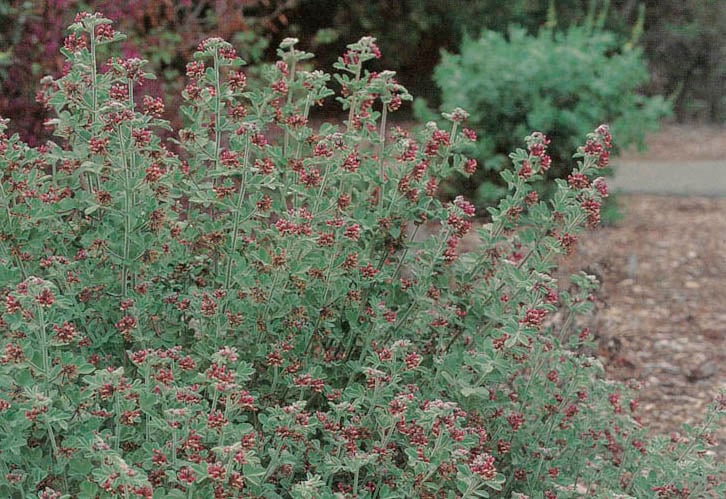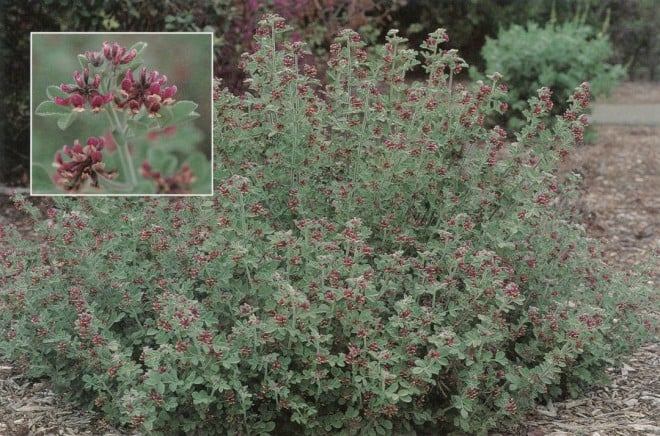

Contributor
- Topics: Archive, Plants You Need

One of the most striking of California’s perennial legumes, Otay Mountain lotus (Lotus crassifolius var. otayensis) is the autumn offering in the Pacific Plant Promotions program. [For more information on the Pacific Plant Promotions program, see the January 2000 issue of Pacific Horticulture].
Equally rare in gardens and in the wild, this softly pubescent, bushy perennial produces upright to arching stems that reach two to five feet tall and spread nearly as wide. The many clusters of clover-like red and white flowers attract bees and are followed by decorative reddish legumes about two inches long. The differing habitats of Otay Mountain lotus in the wild would suggest its adaptability to a range of garden conditions; individuals planted at Rancho Santa Ana Botanic Garden (RSABG) have thrived for over three years in both heavy and sandy soils and in full sun to part shade. Plants begin pushing up new shoots in December or January and are in full flower by late March to early April; a secondary flowering may be seen on smaller, later stems. Because of the unusual red and white color of the flowers and the soft, fuzzy appearance of the foliage, this lotus can be mixed effectively with a wide range of mediterranean climate plants in the garden. Various species of Cistus, Lavandula, Coleonema, Euryops, perennial bunch grasses, and sages, such as Salvia clevelandii, S. mellifera, or S. apiana, would be good companions for this perennial lotus.
The best placement for Otay Mountain lotus is in well-drained soil in a mostly sunny location. Although it grows on slopes in the wild, it has performed well at RSABG on nearly level ground in heavy soil. An important consideration for this lotus is its summer dormancy, when all above-ground activity ceases and the shoots die back During this time, roughly from July to November, its persistent stems—either intact or partly pruned back—can be helpful in keeping track of the plant’s location. Occasional summer watering appears to helps to bring the plants through the dry summer; in the wild, infrequent showers during the summer monsoon period may bring some drought relief to populations of Lotus crassifolius var. otayensis, both on Otay Mountain and south of the border. The most critical time to avoid over-watering is in early summer when the crown is hardening off, and the plant is entering its dormancy. This beautiful perennial is expected to perform well in Sunset zones 18–24, and on warm, sunny sites in zones 14–17. A gravel mulch may be helpful in protecting the plants from excess moisture around the crown and from both winter cold and excessive summer heat.
Described as new to science as late as 1978, Otay Mountain lotus was, until recently, believed to be endemic to Otay Mountain in southern San Diego County, where it grows in openings in dense chaparral at just under 3,000 feet elevation on the northeast side of the mountain. The plants seem to congregate where there is a concentration of seasonal soil moisture. In 1994, the author and two fellow plant explorers, Craig Reiser and Tom Knapik, discovered a population south of the border at the considerably lower elevation of about 900 feet. This occurrence in Mexico represents a new country record for this variety of lotus. At this locality, in the ranch country northwest of Ensenada, the plants grow on a rocky, sunny slope dominated by an as yet undetermined manzanita (Arctostaphylos sp.) and with an attractive but rare sunflower (Verbesina dissita). No lotus plants were found on less rocky hills and flats nearby. At both localities, periodic fires appear to play an important role, both in the reproduction of the species and in the maintenance of a suitable habitat.
The typical variety, Lotus crassifolius var. crassifolius, differs in having glabrous to puberulent (sparsely hairy) foliage and yellow green flowers, with some purplish red tinting. It grows at elevations of up to 8,000 feet from Los Angeles County to the state of Washington. The ranges of the two varieties of this species do not overlap.
Plants for this offering of Otay Mountain lotus have been propagated from material collected by the author, along with RSABG graduate students Victor Steinmann and Gery Allan. Over the past few years, plants have been made available at annual plant sales at RSABG, but otherwise Otay Mountain lotus has received little attention from the horticultural community.
[sidebar]
Lotus crassifolius var. otayensis is a robust perennial, 0.5–1.5 meters tall and about as wide, deciduous in summer. Leaves and stems are softly pubescent, leaves parapinnate or imparapinnate, about 5 centimeters long and 3–4 centimeters wide, with leaflets 1.5–2.5 centimeters long and 1–1.5 centimeters wide. Inflorescences are solitary and axillary; the peduncle 2–5 centimeters long and ascending; flower heads umbel-like, one-sided, 6–10 flowered; flowers spreading to ascending, with the calyx 6–7 millimeters long and maroon; corolla about 15 millimeters long, bilabiate, with the lower portion (wings and keel) creamy white and the upper portion (banner) maroon to wine red. Fruits are about 5 centimeters long, glabrous, tinged with red; seeds are rounded, flattened, 2 millimeters in diameter, and dark brownish green.
[/sidebar]
Share:
Social Media
Garden Futurist Podcast
Most Popular
Videos
Topics
Related Posts

Low Maintenance Gardens – Better for Pollinators and People
Autumn 2022 “I come out every day. It’s therapy, my meditation.” Janet’s young garden transformed from overgrown, invasive plants to mostly natives. The dailiness of

Calochortophilia: A Californian’s Love Affair with a Genus
Summer 2022 I can chart the progression of my life by Calochortus. For the last two decades, at least. As a teenage girl growing up

Pacific Plant People: Carol Bornstein
Spring 2022 Public gardens play a key role in demonstrating naturalistic planting design, selecting native and adapted plants for habitat, and testing techniques for reducing

Add Year-Round Interest and Winter Blooms for Pollinators
Spring 2022 This article was created from an Interview by Merrill Jensen with Neil Bell in the Summer of 2021 for our Pacific Plant People









Responses